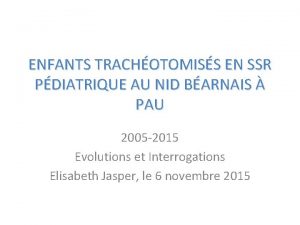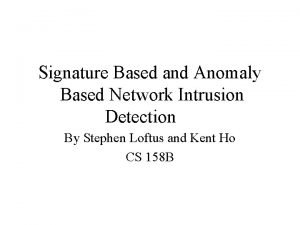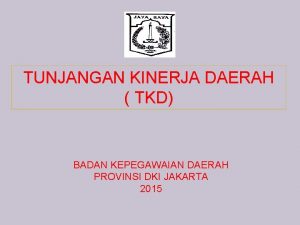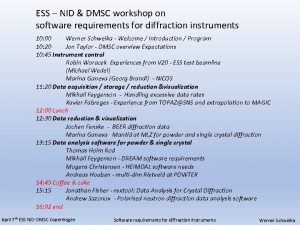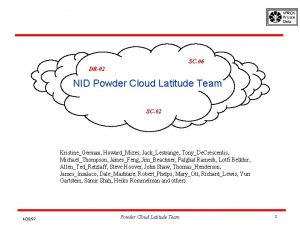District Medical Officers NID 2019 New Initiatives in


























- Slides: 26

District Medical Officers’ NID 2019 & New Initiatives in RI Workshop DHO Office Meeting Hall Bidar

Introduction of Tetanus and adult Diphtheria (Td) vaccine in UIP Dr. Anilkumar S. Talikoti SMO WHO - India, Kalaburagi

Respiratory Diphtheria • Acute communicable upper respiratory illness caused by toxigenic strains of Corynebacterium diphtheriae (Gm +Ve bacillus) • The illness is characterized • Membranous inflammation of upper respiratory tract, usually pharynx but sometimes posterior nasal passages, larynx, and trachea • Widespread damage to other organs, primarily the myocardium and peripheral nerves. • Potent exotoxin produced by C. diphtheriae causes extensive membrane production and organ damage. • Cutaneous form of diphtheria commonly occurs in warmer climates or tropical countries.

Respiratory Diphtheria • Transmission mainly person to person for C. diphtheriae through respiratory contact. • Onset of respiratory diphtheria occurs after an incubation period of 2– 5 days • Mild fever & an exudative pharyngitis which organizes into a pseudo-membrane on pharynx, larynx, tonsil causing obstruction of the airways. Bull neck appearance. • Complications of heart (myocarditis), nervous system (neuritis), blood (thrombocytopenia) may occur • Diphtheria antitoxin (DAT) is highly effective and is the gold standard for treatment. • Case-fatality rates exceeding 10% have been reported, in particular where DAT is unavailable

Suspected Case Clinical Examination Meets Case Definition Yes Positive No Sample Lab Result No Negative Epidemiological linkages Yes Laboratory confirmed Epidemiologically confirmed Acknowledgement: Slide taken from Tamil Nadu state presentation No Clinically Confirmed Rejected

Global Burden of Diphtheria • Overall Global burden is declining, • Large outbreaks have occurred in 2017 and 2018 in a growing number of countries including Bangladesh, Indonesia, Kenya, Philippines, South Africa, Venezuela, and Yemen, among others attracting global attention • SEAR remains major contributor to Diphtheria cases • Under reporting, mostly clinical diagnosis, problem may be bigger 100000 90000 70000 60000 50000 40000 SEAR 30000 Global 20000 10000 2017 2016 2015 2014 2013 2012 2011 2010 2009 2008 2007 2006 2005 2004 2003 2002 2001 Year 2000 1999 1998 1997 1996 1995 1994 1993 1992 1991 1990 1989 1988 1987 1986 1985 1984 1983 1982 1981 0 1980 Number of Diphtheria Cases 80000

Diphtheria burden- SEAR and India • As per the report on Review of the Epidemiology of Diphtheria- 2000 -2016, US- CDC, 5 years average of reported diphtheria cases are more in South East Asia Region of WHO , particularly in India. • From 2011– 2015, India had the largest number of reported cases (18, 350 cases)- WHO Position paper on Diphtheria- August 2017

Diphtheria burden in India • Reported cases of Diphtheria in India has a fluctuating trend. • Lab supported VPD surveillance in India is expanding - more clear picture expected in coming time 7000 6094 No. of reported cases 6000 5293 5000 3812 4000 3977 4233 3529 3434 3380 3133 3000 2525 2365 2000 1000 0 2005 2007 2009 2011 2013 2015 2017 2019 Diphtheria Reported Cases Source: WHO VPD monitoring system. 2018 global summary (data as on 15/07/2018) 8

Epidemiology of Diphtheria in India- Age-wise distribution 2017 Bihar, UP, MP, Kerala, HR 2018 Bihar. UP, MP, Kerala, HR, HP, Punjab N= 464 N= 1616 6% 14% 17% 42% 31% 17% 35% 38% Most of the cases of Diphtheria are occurring in age group 5 years and above 77% and 69% respectively in 2017 and 2018 *: VPD surveillance data as on 1 September 2018

Vaccination status of Diphtheria cases 2017 Bihar, UP, MP, Kerala, HR 2018 Bihar. UP, MP, Kerala, HR, HP, Punjab [PERCENTAGE] N= 1616 6% 14% 8% 9% 3% N= 464 65% 69% 5% 10% 3% 5% Most of the cases (~ 2/3 rd of Diphtheria are occurring in unvaccinated as expected) *: VPD surveillance data as on 1 September 2018

Data from Diphtheria cases- Kerala outbreak 2016 N= 526 Age wise distribution 7% Vaccination Status 3% 18% 79% 75% Fully vaccinated <5 yrs 5 to 10 yrs >=10 yrs Partial vaccinated Unvaccinated

Data from Uttar Pradesh, 2016 -18, Line listing of Diphtheria cases Vaccination Status Age-wise distribution N= 1888 15% 34% 32% 66% 53% <5 yrs 5 to 10 yrs >=10 yrs For the year 2018, data as on 1 September 2018 Vaccinated Unvaccinated

Rationale for Td vaccine. . Ø Diphtheria cases occurring in all age groups including older children and adults, majority in unvaccinated Ø immunity to diphtheria subsides following the primary series of DTP infant immunization Ø Eastern Europe and South America experienced serious outbreaks in early and mid-90’s. These regions changed to Td vaccine which resulted in sharp decline of diphtheria outbreaks there Ø Now it is established that booster doses of diphtheria toxoid containing vaccines are needed for continued protection Ø more than 80% reduction in tetanus mortality since 1999, however diphtheria outbreaks increasing that reflect gaps in diphtheria protection

Global Recommendations for Diphtheria vaccination • Since 1998, WHO has recommended that TT should be replaced by Td vaccine. This is reiterated in the WHO tetanus vaccine position paper of 2017 • SAGE has recommended (1998, 2002, 2016) to use Td rather than TT • Global uptake for this recommendation so far is slow since diphtheria is underreported and has not emerged as a public health priority in many countries. 133 countries using Td/Tdap at present Benefit of the Td: Strengthen immunity against diphtheria while maintaining protection against tetanus as earlier Diphtheria Position Paper Weekly Epid. Record (2017, 92: 417 -436)

Why Td vaccine needed for pregnant women when already TT vaccine is administered • The use of Td in place of TT is recommended during pregnancy to protect against maternal and neonatal tetanus & diphtheria during prenatal care. • Vaccination during pregnancy also serves to boost immunity and increase the duration of protection in those pregnant who had not received the full set of recommended booster doses. • boost Increasing diphtheria immunity in addition to assuring tetanus protection, and help to curtail diphtheria outbreaks.

Mo. HFW letter to States/UTs Mo. HFW has issued letter to States/UTs for introduction of Td vaccine replacing TT in UIP Td will be given to • Children of 10 and 16 years age • Pregnant women • Infants contraindication to pertussis (Penta/DPT)Till now children for whom DPT/Pentavalent vaccine was contraindicated could receive only Hep-B and TT. Now, though not licensed for children <7 years, Td vaccine can also be given in this exceptional situation 17

TT to Td- Effective but operationally simple • Cost-effective to replace, nominal additional cost will save substantial resources for diphtheria outbreak response • Enough production capacity of the country to supply Td needed in programme • No major operational challenges, same as TT 1. 2. 3. 4. 5. 6. 7. Route of administration, Package size, Targets, Schedule, No change in cold chain capacity, No change in vaccine delivery logistics Therefore no separate introduction activities required like for other new vaccines introduction

TT vs Td vaccine. . Characteristic TT vaccine Td vaccine Presentation 10 dose vial Dose and route of administration 0. 5 ml, Intramuscular, Upper arm Heat and freeze sensitivity Heat and Freeze sensitive Same as TT vaccine Storage +2 -8 degree Celcius in ILR Same as TT vaccine Shelf life 24 months 24/36 months depending upon manufacturer Shake test and Open Vial Policy Applicable Same as TT vaccine Permissible wastage <10% AEFI Minor local reactions Same as TT vaccine Same as TT Tetanus and adult diphtheria (Td) vaccine is a combination of tetanus and diphtheria with lower concentration of diphtheria antigen (d) as recommended for older children and adults

Roll out and timeline for Td introduction Dr A S. Rudrawadi RCH Officer, Kalaburagi

Rollout of Td vaccine Workshops: • State & district level workshops to be organized to disseminate information regarding replacement of TT with Td vaccine Trainings • Block level ANM trainings to be held to create awareness Vaccine supply: • Td vaccine will be supplied by Government of India as is done for other vaccines under UIP • Orders placed, supplies likely to commence from November 2018 onwards in phased manner

Stock management of Td vaccine • No requirement for additional cold chain storage capacity to accommodate Td vaccine • If remaining stock of TT vaccine still meets all validity requirements, it should to be used first and then begin using Td vaccine • There is no need to discard or recall stocks of available TT vaccine • Td vaccine can be given as a subsequent dose following TT, and all previous TT doses will remain valid. There is no need to re-start the series

Capacity building and communication for Td vaccine introduction • No separate communication mobilization activities for Td or • awareness will be done during regular RI social communication activities • provide information about the benefits of Td (especially added antigen) to target groups and the stakeholders at the community level during routine immunization IPC meetings • capacity building : Orientation of Health workers and mobilisers on key messages for Td and FAQs and 2 pager shared with States/UTs

Recording & Reporting: Revision of formats Revision of all formats replacing TT with Td is to be done o o o Mother-child protection (MCP) card Due list Tally sheets Vaccine stock form, indenting forms, distribution registers Monthly progress report at all levels Maternal & Child Health (MCH)/Immunization registers Coverage monitoring charts Supervisory checklists Computer databases Immunization coverage surveys and evaluation formats AEFI reporting formats RI microplan 24

Strategies to achieve maximum coverage of Td For Children of 10 and 16 years (school going) • Convergence with School Health and Adolescent Health programme will be used as a platform to generate awareness for pregnant women and adolescents. • States may plan annual campaign with Td vaccine to target children at schools : rough idea is that to cover 5 th standard (10 years) and 10 -11 th standard (16 years) children • Health education sessions conducted under Rashtriya Kishor Swasthya Karyakram may be used to create awareness about Td • States may use its experience and advocacy done during MR campaign For pregnant women • Convergence with Maternal Health programme at various forums • Other RI strengthening activities in general Involvement of private organizations, professional bodies etc. to be done at all levels

Points to Remember Go. I decision already communicated to all States/UTs for introduction of Td replacing TT. There will be no change in UIP schedule. Only Td will be used in place of TT. If both TT and Td are in supply chain at any level, use TT first (TT- First out) Use Td only when TT is exhausted. TT should not be recalled or discarded. Td is a safe vaccine. Any minor, severe & serious AEFI event should be reported as being done for other UIP vaccines. Td will be reported in place of TT till the revision of reporting formats/portals (HMIS, MCTS, RCH register, MCP card etc. ) is done

Training calendar Thank You
 Nid béarnais pau
Nid béarnais pau Nid signature
Nid signature Nrfid
Nrfid Tukin kapan dibayarkan
Tukin kapan dibayarkan Nid
Nid Uk chief medical officers' physical activity guidelines
Uk chief medical officers' physical activity guidelines Delvic sanitation initiatives
Delvic sanitation initiatives Digital initiatives in higher education
Digital initiatives in higher education Crm marketing initiatives
Crm marketing initiatives Empathy and establishing trust with individuals
Empathy and establishing trust with individuals Business development initiatives
Business development initiatives People's initiatives
People's initiatives Nasa access management system (nams)
Nasa access management system (nams) Health initiatives
Health initiatives Service desk improvement initiatives
Service desk improvement initiatives Us soccer player development initiatives
Us soccer player development initiatives Global health initiatives meaning
Global health initiatives meaning Work-life balance presentation
Work-life balance presentation Faa strategic initiatives
Faa strategic initiatives Oahpi
Oahpi Pdhpe ottawa charter
Pdhpe ottawa charter Agency for strategic initiatives
Agency for strategic initiatives American academy of allergy asthma and immunology 2018
American academy of allergy asthma and immunology 2018 Berechs
Berechs Community college business officers
Community college business officers Fort belvoir officers club
Fort belvoir officers club Chief instructional officers california community colleges
Chief instructional officers california community colleges
